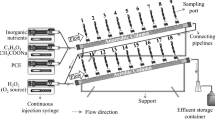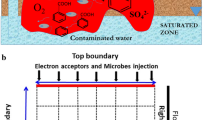Abstract
In this paper, a numerical model is presented that is capable of describing the complex set of biochemical processes that occur in chlorinated aliphatic hydrocarbon (CAH)-contaminated groundwater when an exogenous electron donor is added. The reactive pattern is based on the degradation pathways of both chlorinated ethanes and ethenes, and it includes electron donor production (H2 and acetate) from the fermentation of an organic substrate as well as rate-limiting processes related to electron acceptor competition. Coupling of the kinetic model to a convection–dispersion module is described. The calibration phase was carried out using data obtained at a real CAH-contaminated site in the north of Italy. Model simulations of different application scenarios are presented to draw general conclusions on the effectiveness of reductive dechlorination (RD) as a possible cleanup strategy. Early outcomes indicate that cleanup targets can only be achieved if source longevity is reduced. Therefore, metabolic RD is expected to produce beneficial effects because it is known to induce bioenhanced degradation and transformation of CAHs.











Similar content being viewed by others
References
Aulenta F, Bianchi A, Majone M, Petrangeli Papini M, Potalivo M, Tandoi V (2005a) Assessment of natural or enhanced in situ bioremediation at a chlorinated solvent-contaminated aquifer in Italy: a microcosm study. Environ Int 31:185–190
Aulenta F, Di Fazio A, Leccese M, Majone M, Petrangeli Papini M, Rossetti S, Stracqualursi N, Tandoi V, Viotti P (2005) Assessing the potential for natural or enhanced in-situ bioremediation at a TCE-contaminated site by coupling process analysis and modeling. In: Nutzmann G, Viotti P, Aagaard P (eds) Reactive transport in soil and groundwater. Springer, Berlin, pp. 165–177
Aulenta F, Potalivo M, Majone M, Petrangeli Papini M, Tandoi V (2006a) Anaerobic bioremediation of groundwater containing a mixture of 1,1,2,2-tetrachloroethane and chloroethenes. Biodegradation 17(3):193–206
Aulenta F, Pera A, Rossetti S, Petrangeli Papini M, Majone M (2006b) Relevance of side reactions in anaerobic reductive dechlorination microcosms amended with different electron donors. Water Res 41:27–38
Aulenta F, Canosa A, Leccese M, Petrangeli Papini M, Majone M, Viotti P (2007) Field study of in situ anaerobic bioremediation of a chlorinated solvent source zone. Ind Eng Chem Res 46(21):6812–6819
Bagley DM (1998) Systematic approach for modelling tethrachloroethene biodegradation. J Environ Eng-Asce 124:1076–1086
Balážová A, Slodička M, Van Keer R (2006) Parameter determination for reductive dechlorination of chlorinated solvents. Transp Porous Media 65:411–424
Beretta GP, Bozzano F, Del Bon A, Majone M, Nardoni F, Pacioni E, Petitta M, Viotti P (2006) Multi-scale approach for geological and hydrogeological characterization of a polluted site in the municipality of Rho (MI). In: Proceedings International Conference on the Remediation of Polluted Sites BOSICON, Rome, (CD-Rom)
Boulding RJ. Ginn JS (2004) Practical handbook of soil, vadose zone, and ground-water contamination: assessment, prevention, and remediation
Bozzano F, Petitta M, Del Bon A, Nardoni F, Pacioni E (2007) Conceptual model and flow numerical simulation of aquifer contaminated by chlorinated solvents in Rho (MI). Ital J Eng Geologi Enviroment Spec Issue 1:97–105
Clapp LW, Semment MJ, Novak PJ, Hozalski RM (2004) Model for in situ perchloroethene dechlorination via membrane-delivered hydrogen. J Environ Eng-ASCE 130(11):1367–1381
Clement PT, Johnson CD, Sun Y, Klecka GM, Bartlett C (1998) Natural attenuation of chlorinated ethane compounds: model development and field-scale application at the Dover site. J Cont Hydrol 42:113–140
Clement PT, Truex MJ, Lee P (2001) A case study for demonstrating the application of U.S. EPA’s monitored natural attenuation screening protocol at a hazardous waste site. J Cont Hydrol 59:133–162
Fennel DE, Gosset JM (2003) Microcosms for site specific evaluation of enhanced biological reductive dehalogenation. In: Häggblom, M.H. Bossert ID (eds) Dehalogenation: microbial processes and environmental applications. Kluwer Academic Publisher, Amsterdam, pp. 1–11
Fennell DE, Gossett JM (1998) Modeling the production of and competition for hydrogen in a dechlorinating culture. Environ Sci Technol 32:2450–2460
Fennell DE, Carroll AB, Gossett JM, Zinder SH (2001) Assessment of indigenous reductive dechlorinating potential at a TCE-contaminated site using microcosm, polymerase chain reaction analysis, and site data. Environ Sci Technol 35:1830–1839
Grostern A, Edwards EA (2006) Growth of Dehalobacter and Dehalococcoides spp. during degradation of chlorinated ethanes. Appl Environ Microb 72(1):428–436
Harbaugh AW, Banta ER, Hill MC, McDonald MG (2000) MODFLOW-2000, the U.S. Geological Survey modular groundwater model. User guide to modularization concepts and the ground-water flow processes. U.S. Geological Survey Open-File Report 00–92, 121. USGS, Reston
Kuchovsky T, Sracek O (2007) Natural attenuation of chlorinated solvents: a comparative study. Environ Geol 53:147–157
Löffler FE, Tiedje JM, Sanford RA (1999) Fraction of electrons consumed in electron acceptor reduction and hydrogen thresholds as indicators of halorespiratory physiology. Appl Environ Microb 65(9):4049–4056
Logan BE, Sang-Eun O, In SK, Van Ginkel S (2002) Biological hydrogen production measured in batch anaerobic respirometers. Environ Sci Technol 36(11):2530–2535
Lorah MM, Voytek MA (2002) Degradation of 1,1,2,2-tetrachloroethane and accumulation of vinyl chloride in wetland sediment microcosms and in situ porewater: biogeochemical controls and associations with microbial communities. J Cont Hydrol 70:117–145
Luciano A, Petrangeli Papini M, Viotti P (2010) Laboratory investigation of DNAPL migration in porous media. J Hazard Mater 176:1006–1017
Luciano A, Viotti P, Petrangeli Papini M (2012) On morphometric properties of DNAPL sources: relating architecture to mass reduction. Water Air Soil Poll 223(5):2849–2864
Nobre RC, Nobre MM (2004) Natural attenuation of chlorinated organics in a shallow sand aquifer. J Hazard Mater 110:129–137
Rivett MO, Feenstra S, Cheny JA (2001) A controlled field experiment on groundwater contamination by a multicomponent DNAPL: creation of the emplaced-source and overview of dissolved plume development. J Cont Hydrol 49(1–2):111–149
Roy JW, Smith JE, Gilham RW (2002) Natural remobilization of multicomponent DNAPL pools due to dissolution. J Cont Hydrol 59(3–4):163–186
Rossetti S, Aulenta F, Majone M, Crocetti G, Tandoi V (2008) Structure analysis and performance of a microbial community from a contaminated aquifer involved in the complete reductive dechlorination of 1, 1, 2, 2‐tetrachloroethane to ethene. Biotechnol Bioeng 100(2):240–249
Smatlak CR, Gossett JM, Zinder SH (1996) Comparative kinetics of hydrogen utilization for reductive dechlorination of tetrachloroethene and methanogenesis in an anaerobic enrichment culture. Environ Sci Technol 30:2850–2858
Suthersan S (2002) Natural and Enhanced Remediation Systems. Lewis Publishers
Tandoi V, Di Stefano T, Bowser P, Gosset JM, Zinder SH (1994) Reductive dehalogenation of chlorinated ethenes and halogenated ethanes by a high rate anaerobic enrichment culture. Environ Sci Technol 28:973–979
Tosco T, Bosch J, Meckenstock R, Sethi R (2012) Transport of ferrihydrite nanoparticles in saturated porous media: role of ionic strength and flow rate. Environ Sci Technol 46:4008–4015
Wiedemeier TH, Rifai HS, Newell CJ, Wilson JT (1999) Natural attenuation of fuels and chlorinated solvents in the subsurface. Wiley, New York
Witt ME, Klecka GM, Lutz EJ, Ei TA, Grosso NR, Chapelle FH (2000) Natural attenuation of chlorinated solvents at Area 6, Dover Air Force Base: groundwater biogeochemistry. J Cont Hydrol 57:61–80
Wood RC (2005) Modeling application of hydrogen release compound to effect in situ bioremediation of chlorinated solvent-contaminated groundwater. Thesis Air Force Institute of Technology
Yu S, Dolan ME, Semprini L (2005) Kinetics and inhibition of reductive dechlorination of chlorinated ethylenes by two different mixed cultures. Environ Sci Technol 39(1):195–205
Acknowledgment
This research was financially supported by the European Union (European Commission, FP7 contract no. 213161).
Author information
Authors and Affiliations
Corresponding author
Additional information
Responsible editor: Michael Matthies
Rights and permissions
About this article
Cite this article
Viotti, P., Di Palma, P.R., Aulenta, F. et al. Use of a reactive transport model to describe reductive dechlorination (RD) as a remediation design tool: application at a CAH-contaminated site. Environ Sci Pollut Res 21, 1514–1527 (2014). https://doi.org/10.1007/s11356-013-2035-9
Received:
Accepted:
Published:
Issue Date:
DOI: https://doi.org/10.1007/s11356-013-2035-9




